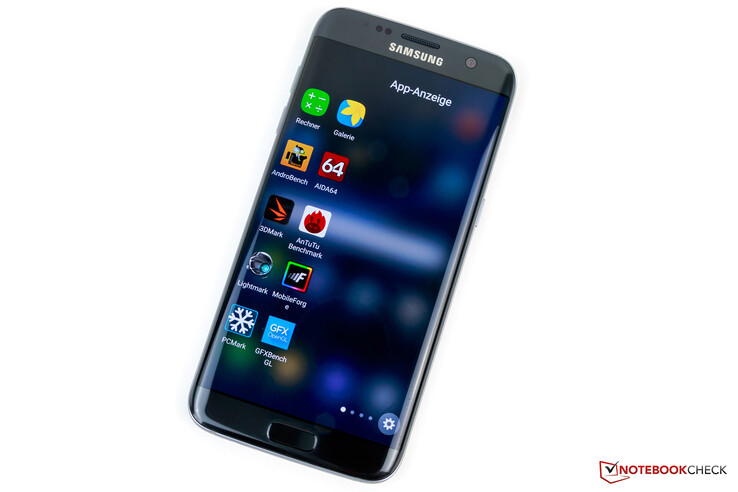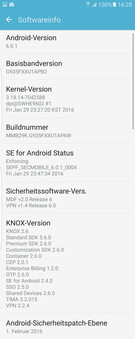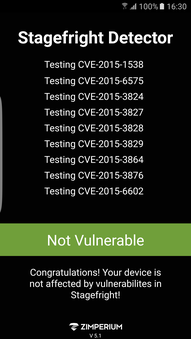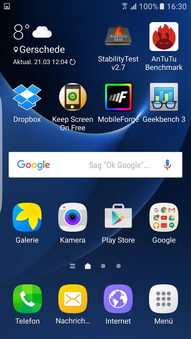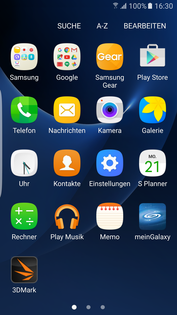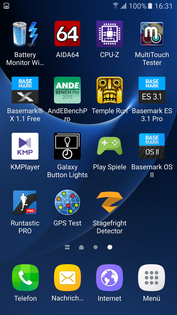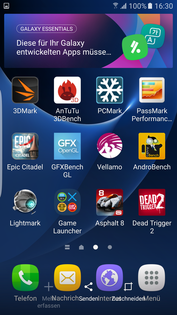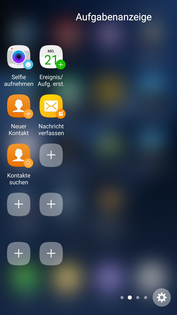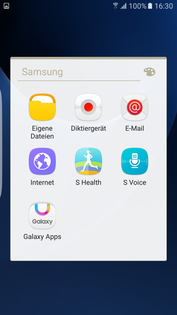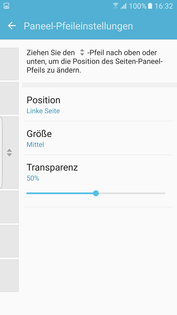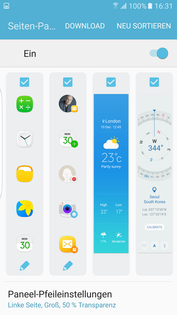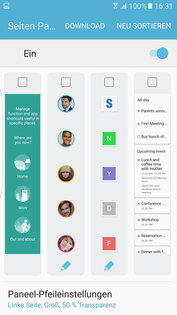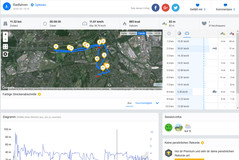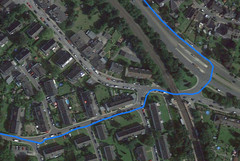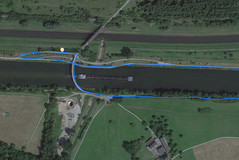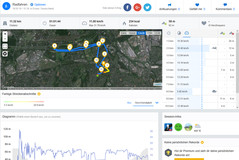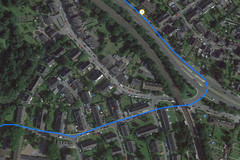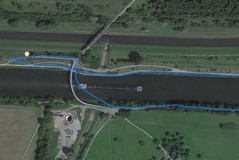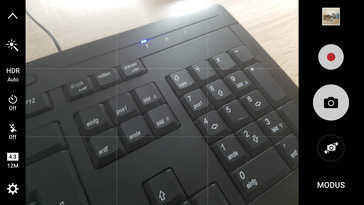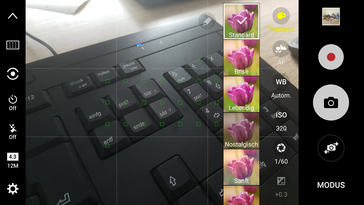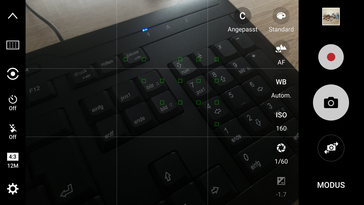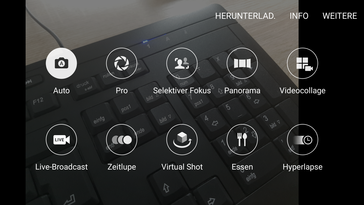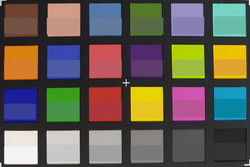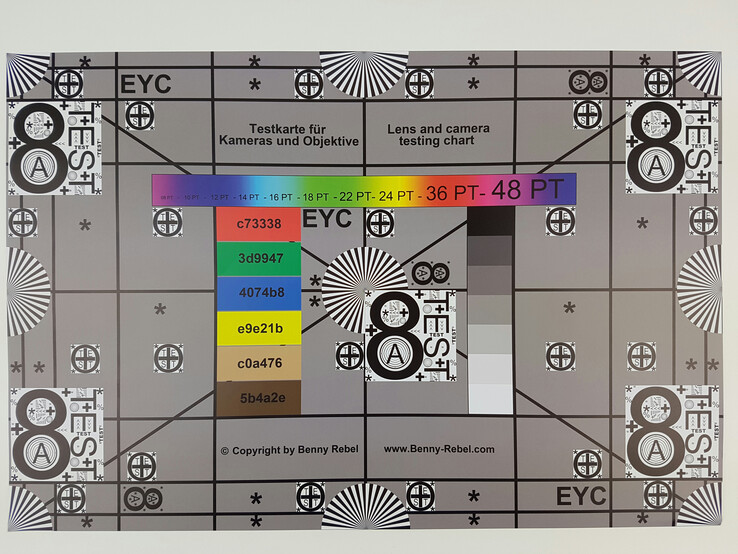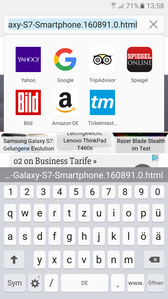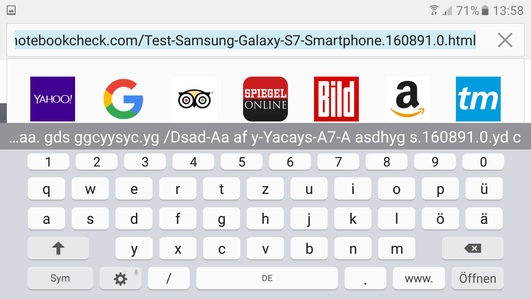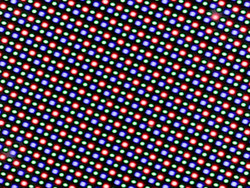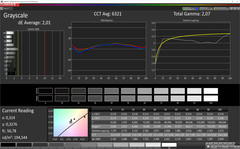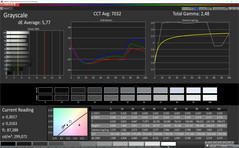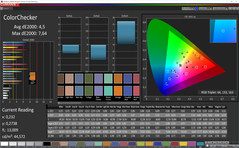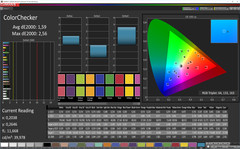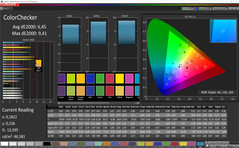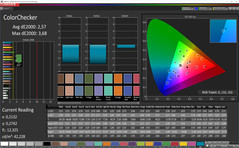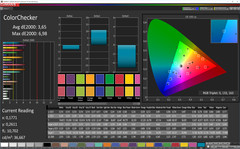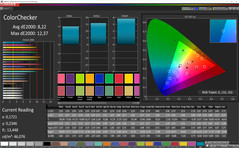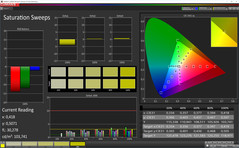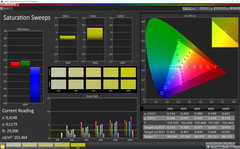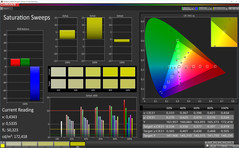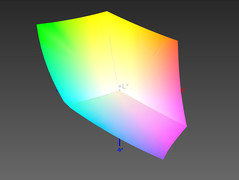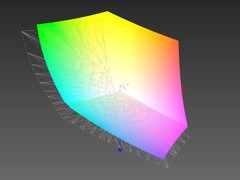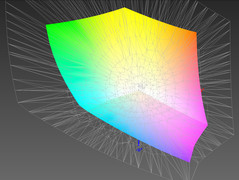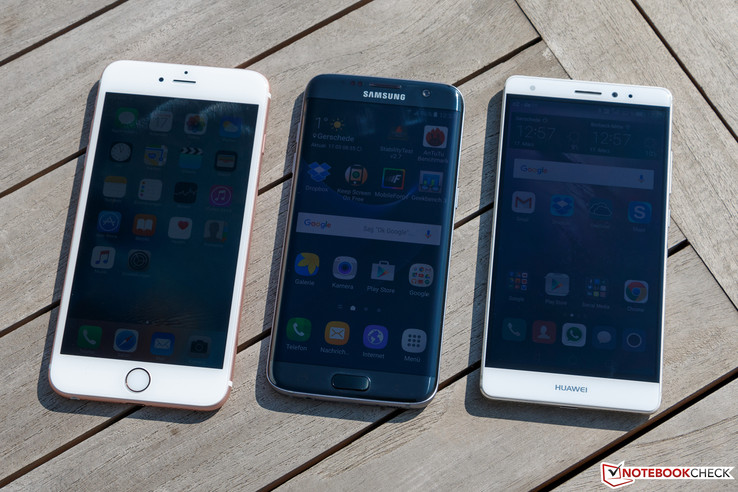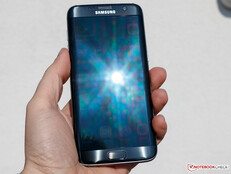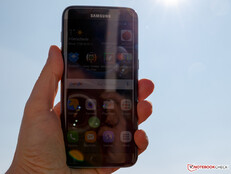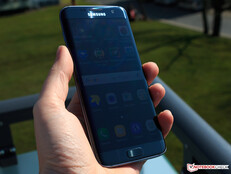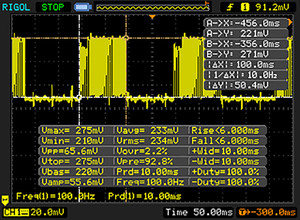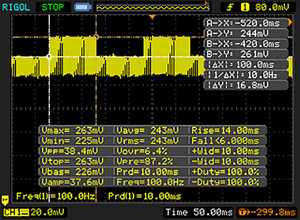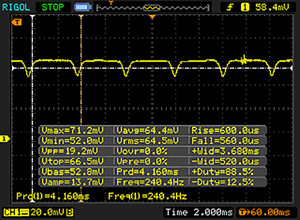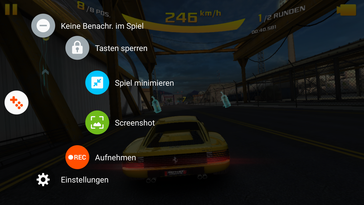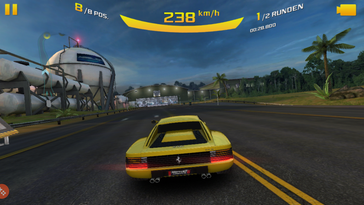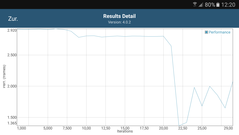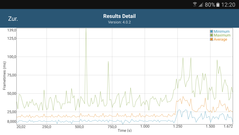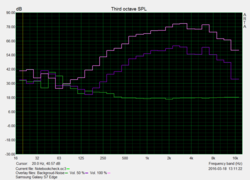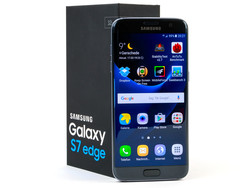Samsung Galaxy S7 Edge Smartphone Review
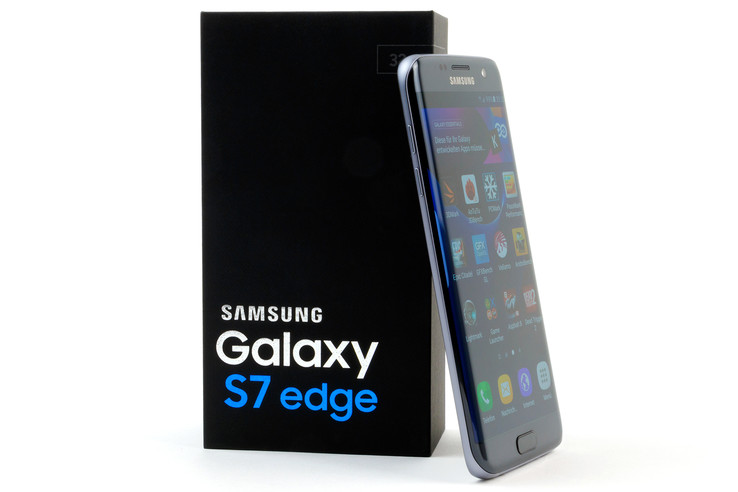
For the original German review, see here.
There are now two versions of the Galaxy S lineup, and even three of the S6 at the end. In addition to the Galaxy S6, an Edge version (both 5.1-inches) and an S6 Edge Plus model (5.7-inches) exist. However, we are not expecting the latter for the new S7 lineup because the Galaxy S7 still features a display diagonal of 5.1-inches in contrast to the larger screen of the S7 Edge. It has a screen diagonal of 5.5-inches and has the well-known dual-edge on both sides. Those are the only differences since the Galaxy S7 is also powered by an Exynos 8890 SoC with 4 GB of working memory and even the camera modules are identical.
Unfortunately, only the 32 GB UFS 2.0 flash memory model will be available in Europe. The 64 GB model is reserved for the Asian market. The 128 GB model has been axed, but the optional storage expansion via micro-SD card has returned to Samsung's flagship. The price for the Edge model has dropped and can now be purchased for 799 Euros (~$892, RRP). It is also again dust and water-proof, which was part of the Galaxy S5's specifications for the first time.
Rivals are found throughout the entire premium range. Among them: Microsoft's Lumia 950 XL, Apple's iPhone 6s Plus, Google's Nexus 6P, Motorola's Moto X Force, Huawei's Mate S and Mate 8, LG's G4, Sony's Xperia Z5 Premium, OnePlus' 2, and HTC's One M9. The HTC and LG comparison devices are models from last year, and particularly LG's G5 is deemed a hot opponent for Samsung's Galaxy S7 Edge.
Case
Samsung's Galaxy S7 Edge has not changed much in terms of appearance. Besides the bigger screen, primarily the rounded edges are noticed. The aluminum bezel looks good and also feels great. The same is true for the Corning Gorilla Glass 4 that is on both the front and the rear. The device is really comfortable to hold although the S7 is even a touch more pleasant because its narrow aluminum bezel on the sides simply feels a bit more edgy than the round curve of the S7 Edge.
The Galaxy S7 Edge is now a bit taller and, according to Samsung, has grown by 0.7 millimeters to 7.7 millimeters. However, we measured 7.85 millimeters in the device's center, 8.1 millimeters in the home button area and 8.5 millimeters at the camera. It is nevertheless extremely slim. Pleasingly, the camera bulge has decreased visibly.
The stiffness and build quality of the Galaxy S7 Edge are also very good. The gaps are even and not too wide. Only the SIM slot could be a bit more flush with the rest of the casing. Besides that, it is too bad that it is completely made of plastic because that not only affects the tray's stiffness, but it could also discolor with time. The European model conceals both a nano-SIM slot and a micro-SD card slot behind this recess. A dual-SIM model is also available in other countries.
The smartphone's rigidness does not give any reason for complaint, either. Although a quiet cracking is heard under high pressure, wave formation does not at all appear on the screen thanks to the used OLED panel.
As to user-friendliness, our colleagues at iFixit examined Samsung's Galaxy S7 Edge closer. They praised the fact that many components in the device are easy to replace; for example, replacing the non-removable battery is now easier. In return, the display has to be removed for replacing the USB port. Besides that, the glass on both sides makes it difficult to open the smartphone at all, especially since glue has been used massively on the back. Consequently, the Galaxy S7 Edge only achieves 3 of 10 possible points here.
Connectivity
Samsung has made some cutbacks in connectivity. The FM radio was already omitted in the Galaxy S6 Edge, and we hoped that the manufacturer would have the courage and install a DAB+ receiver like, for example, LG does in the Stylus 2.
Like in the Galaxy S6 Edge+, the infrared transmitter has also been axed. Upon inquiry, Samsung answered that simply not enough buyers use this feature.
The Galaxy S7 Edge presents itself as a bit old-fashioned with its USB port. It is still a micro-USB port in standard 2.0. Since Samsung strongly markets its newest smartphone in conjunction with the Gear VR that we extensively looked at in the review of the Galaxy S7, the lack of a USB Type-C port will likely be founded here. The Gear VR needs a micro-USB port to connect with the smartphone. Nevertheless, a weak reason for using an outdated interface that is inappropriate for a high-end smartphone anno 2016.
Beyond that, this port only has limited capabilities because it does not support SlimPort or MHL, making it impossible to transmit content to a larger monitor via a cable. DLNA is also absent. In return, at least Wi-Fi Direct and Miracast are supported (Smart View). We tested the latter using an Amazon Fire TV Stick. Although that functioned quite well in practice, playing a Full HD video would unfortunately likely bring the combination to its limits. The image displayed a multitude of artifacts and stuttered permanently. However, the given performance is sufficient for presenting photos.
Support for Ant+, Bluetooth 4.2 and NFC are also present.
Software
The software configuration of the Galaxy S7 Edge is identical with that of the standard S7 model. Google's Android 6.0.1 Marshmallow is installed. It had the security patch level from February 2016 at test time. It will be interesting to see how well Samsung will maintain this patch level. Samsung's KNOX 2.6 is also on board. The manufacturer relies on its proprietary TouchWiz UI user interface so that Samsung users will not see much of a difference despite the newer operating system.
Samsung's own app store is also preloaded again. Some users complained that Samsung Music is no longer installed, but it can be easily downloaded via Galaxy Apps. Unfortunately, the manufacturer also preloads many applications on the smartphone that can be faded out but not completely uninstalled. Among them we find Facebook, WhatsApp as well as Microsoft's Office apps. A modernized news app dubbed upday is also integrated. Well known apps, such as S Health, S Voice, Samsung Gear and S Planner, can be used directly.
The side screen is a unique selling point of the Galaxy S7 Edge. It again provides all features found in the Galaxy S6 Edge and has been expanded slightly. The side screen can be used on either the right or left edge. The side screen arrow can be set in three different sizes and in different positions. It is also possible to select a transparency up to invisible.
The features of the Edge screen have been extended a bit. In addition to only displaying up to ten favorite apps directly, short cuts for specified tasks, such as writing messages, making appointments or taking selfies, can be created. Favorite contacts, the weather, calendar and so-called Quick Tools are also options. The latter is known from the Galaxy Note 4 Edge, and contains a ruler, a compass and quick access on flashlight with five levels, among other things. A few, additional bars can be downloaded, some for an extra charge.
The Edge can also be used for visual status notifications about calls when the smartphone is placed on the screen. Besides that, additional content can also be displayed there in standby. The features have been extended slightly, but a lot of scrolling will be necessary when many bars are used, making it still faster to manage things via the home screen.
Communication & GPS
Unfortunately, Samsung does not make any exact specifications about the LTE modem installed in the Galaxy S7 Edge. The known specs identify it as a Cat. 9 model (max. download: 450 MBit/s, upload: 50 MBit/s). Presumably, the WWAN module by Samsung is used, which was also used in the Galaxy S6 Edge+. It would then have a wide frequency configuration. Samsung has not yet confirmed that, though. The S7 Snapdragon model has an advantage here because, according to Qualcomm, the new X12 LTE modem promises both better reception qualities as well as higher data rates (max. 600 MBit/s download, 150 MBit/s upload), providing the mobile network supports that. The smartphone presented a decent connection to the mobile network in real-world use; we did not notice any unusual interference.
The Wi-Fi module in Samsung's Galaxy S7 Edge supports the IEEE 802.11 a/b/g/n/ac standards, and can transmit in both the 5.0 and 2.4 GHz networks. It also provides MIMO antenna technology. The smartphone's reception quality is very good. The device still displayed a decent signal at approximately 14 meters away from the access point (Devolo dLAN 1200+ Wi-Fi ac, 2.4 GHz), through two indoor walls, and the signal attenuation of -61 dBm was low. No limitations were experienced when browsing the Internet or streaming HD videos.
Samsung's Galaxy S7 Edge uses the GPS, Glonass and BeiDou satellite networks for localization. It finds satellites very quickly indoors with an accuracy of up to four meters. A feat that gave us hope for the comparison test with Garmin's Edge 500.
Unfortunately, it was not as good as expected but is still on a good level. The deviations over the total route remain below 2%. That is mainly because the smartphone does not update its position as frequently as the bike computer. However, minor irregularities are also observed in the area of the bridge. Primarily the iPhones regularly prove that even smartphones can do better. The given performance is more than sufficient for navigating, and the Galaxy S7 Edge is well-equipped for geocaching and fitness tracking.
Telephone & Call Quality
Compared with the predecessor, the phone app in Samsung's Galaxy S7 Edge has not been modified, and its structure is very similar to that of Google's stock app. It is positive that the smartphone does not have to be rebooted when swapping the SIM card and/or micro-SD card.
The smartphone's call quality appealed to us. We made test calls via Skype and the mobile network. The contact was well-intelligible and we were also understood clearly. Samsung could only work on improving noise suppression a bit. Although the Galaxy user's voice was much louder, the background was still well-audible. The quality is poorer via the speaker. The microphone apparently does not have a long range, and thus we were only heard quietly at an arm's length. The included headset surprised us positively; although our contact's voice sounded a bit stifled, the integrated microphone transmitted our voice very clearly.
Cameras
The camera equipment is identical with that of the Galaxy S7 model. However, Samsung uses different sensors for the primary lens; one is its own sensors and the other Sony's IMX 260. The latter is installed in our review sample. We cannot conclusively say whether it also features dual-pixel technology. We are waiting for Samsung to answer this. Unlike previously, the camera's resolution has not been increased further, but shrunk to 12 megapixels. However, that does not affect the outstanding quality. In addition to multiple features, the imaging performance and comparatively high range of dynamics are compelling. The photos are very sharp and very bright. The big aperture of f/1.7 promises high light sensitivity without major haziness at the edges of the photo. Outlines are sharper than, for example, from the iPhone 6s Plus, but Apple's smartphone has a slightly better color reproduction.
The S7 Edge can fully present its strengths in low-light conditions and brightens the surroundings very strongly (scene 3) - even brighter than reality, although the outlines are then also lightly frayed. Settings can be selected manually in the Pro Mode, and RAW format is supported. The light sensitivity can be set from ISO 100 to 800, and the shutter speed from 1/24000 to 10 seconds. Users who work with the Pro Mode will have to acclimatize a bit at first though because the Live View display was not always reliable in the test. Samsung will have to improve this with an update.
The front-facing camera has the same aperture as its rear-facing counterpart, but it only has a resolution of 5 MP. An automatic HDR mode is used here. Diverse Beauty modes can also be selected. We really liked the photos; the lens definitely belongs to the better of its kind.
Color Accuracy & Sharpness
We took a closer look at the imaging performance of Samsung's Galaxy S7 Edge under controlled light conditions. The test chart is photographed as full-screen as possible, and the photo is not edited afterward. The degree of sharpness is tremendously high primarily in the image center. Areas with shifting colors are no problem for the smartphone, either. Blurriness only starts at the corners and outmost edges, but that is absolutely legitimate.
We photographed the X-Rite ColorChecker Passport under identical conditions. The photo was not edited afterward in this case, either. Unlike the practical photo (scene 2), a slight oversaturation of reproduced colors is seen here, which gives the photos a higher brilliancy. The white balance is relatively warm, but it is on a good level.
Videos
Samsung's Galaxy S7 Edge can record videos in multiple video formats. Starting at 480p, Full HD and QHD over the small HD resolution (1280x720 pixels) and 1:1 recordings (1440x400 pixels), Full HD and QHD up the latest Ultra HD (3840x2160 pixels, 30 fps, 47 MBit/s). However, Samsung still uses conventional Full HD (1920x1080 pixels, 30 fps, 17 MB/s) for the focus since it is the highest possible resolution that is available for features like HDR, tracking auto-focus and different video effects. That is unfortunately not available for 1080p at 60 fps (27.5 MBit/s). The frame rates are also highly optimized for non-European markets. 24, 25 or 50 fps do not exist.
The image quality is impressive, and the optical image stabilizer even functions freehandedly on a bicycle (1080p @30 fps) very well. Unfortunately, the unedited sample videos on YouTube do not look as good as the originals. They presented a good image sharpness and good scope of dynamics. The sound is also compelling.
Accessories
Samsung's Galaxy S7 Edge smartphone comes with a modular power supply that has a nominal output of 10 watts (5 volts, 2 ampere), an in-ear headset with earplugs in different sizes, a small tool for opening the card slot and folder with a quick-start guide, security notes and warranty conditions. An OTG adapter that can be used for transferring data from the old phone as well as a conventional OTG adapter is also in the smartphone's box.
Covers, additional batteries, sleeves, chargers and more items tailored for the S7 Edge are optionally available in Samsung's Shop.
Warranty
Samsung includes a 24-month warranty on its smartphone. The accessories are covered for six months, and the battery for twelve months.
Input Devices & Handling
Samsung's Galaxy S7 Edge has a 5.5-inch capacitive touchscreen that is extremely sensitive and which can detect up to ten fingers simultaneously. The inputs are implemented fast and reliably. The S7 Edge does not feature a pressure sensitive screen like in the iPhone 6s Plus. We also looked at the touchscreen's behavior under water since the smartphone is water and dust-proof in accordance with IP8. Inputs can be prompted on the screen when water touches it, which is nothing unusual. That does not function as well under water; the camera can be launched by double-clicking the home button, and the volume buttons can be used as the release.
The physical buttons make a very high-quality impression. Their pressure point is crisp and accurate, and they do not give reason for complaint. Tapping the home button three times consecutively launches single-hand mode, which has to first be enabled in the settings. Unfortunately, it cannot be used in landscape mode, where it directly changes back to default use. A fingerprint scanner is integrated into the home button that functioned reliably and fast in the test. Unfortunately, it does not offer any additional features like the case in Huawei's Mate S.
Samsung installs its well-known keyboard layout that supports swiping and voice inputs. Other layouts can also be downloaded from Google's Play Store. Another useful feature is the extended screenshot functions (pressing power and home buttons simultaneously). The user can subsequently decide whether more content, e.g. a website, or only a section is to be captured.
Display
Compared with its predecessor, Samsung's Galaxy S7 Edge has grown a bit and now has a size of 5.5-inches. It has a resolution of 2560x1440 pixels (QHD), which results in a lush pixel density of 534 PPI. Only Sony's Xperia Z5 Premium (Ultra HD, 801 PPI) outshines that. The offered resolution is more than sufficient for routine use; the displayed content always looks razor-sharp. However, anyone who uses Samsung's Gear VR will wish that the Korean manufacturer had opted for a higher-resolution screen. Single pixels become visible when looking closer since only half the pixel count is available to each eye and the device is very close to the visual organ.
Samsung touts the screen's Always On function as an additional feature. It allows permanently displaying the time, calendar and notifications when the device is in standby. Actually nothing new seeing that the Lumia 950 XL and some of its predecessors have a similar feature (Glance).
In terms of brightness and contrast, the Super AMOLED screen by Samsung delivers top rates. We measured it with an enabled brightness sensor. The smartphone just achieves 264 cd/m² in the panel's center when manual mode is selected. The evaluation of equally distributed dark and bright areas is more relevant for practice (APL 50). The Galaxy S7 Edge achieves up to 728 cd/m² in this scenario, which is even slightly higher than that of the smaller S7 model (max. 684 cd/m²). The brightness distribution is also on an excellent level.
| |||||||||||||||||||||||||
Brightness Distribution: 96 %
Center on Battery: 554 cd/m²
Contrast: ∞:1 (Black: 0 cd/m²)
ΔE Color 1.59 | 0.5-29.43 Ø5
ΔE Greyscale 2.01 | 0.57-98 Ø5.3
99.98% sRGB (Argyll 1.6.3 3D)
82.12% AdobeRGB 1998 (Argyll 1.6.3 3D)
93.8% AdobeRGB 1998 (Argyll 2.2.0 3D)
100% sRGB (Argyll 2.2.0 3D)
86% Display P3 (Argyll 2.2.0 3D)
Gamma: 2.01
| Samsung Galaxy S7 Edge Super AMOLED, 2560x1440, 5.50 | Samsung Galaxy S6 Edge Super AMOLED, 2560x1440, 5.10 | Sony Xperia Z5 Premium IPS, 3840x2160, 5.50 | Microsoft Lumia 950 XL AMOLED, 2560x1440, 5.70 | Apple iPhone 6S Plus IPS, 1920x1080, 5.50 | Google Nexus 6P AMOLED, 2560x1440, 5.70 | Huawei Mate 8 IPS-NEO, 1920x1080, 6.00 | |
|---|---|---|---|---|---|---|---|
| Screen | -21% | -202% | -35% | -36% | -14% | -79% | |
| Brightness middle | 554 | 343 -38% | 560 1% | 297 -46% | 583 5% | 363 -34% | 514 -7% |
| Brightness | 552 | 338 -39% | 541 -2% | 297 -46% | 560 1% | 365 -34% | 513 -7% |
| Brightness Distribution | 96 | 94 -2% | 85 -11% | 93 -3% | 91 -5% | 90 -6% | 94 -2% |
| Black Level * | 0.45 | 0.46 | 0.35 | ||||
| Colorchecker dE 2000 * | 1.59 | 2.2 -38% | 9.19 -478% | 2.67 -68% | 3.55 -123% | 2.34 -47% | 5.08 -219% |
| Colorchecker dE 2000 max. * | 2.56 | 15.01 -486% | 3.98 -55% | 8.28 -223% | |||
| Greyscale dE 2000 * | 2.01 | 2.37 -18% | 10.58 -426% | 2.81 -40% | 3.88 -93% | 1.03 49% | 5.49 -173% |
| Gamma | 2.01 109% | 2.41 91% | 2.7 81% | 2.08 106% | 2.2 100% | 2.23 99% | 2.08 106% |
| CCT | 6321 103% | 6425 101% | 9760 67% | 6379 102% | 7280 89% | 6429 101% | 7254 90% |
| Color Space (Percent of AdobeRGB 1998) | 82.12 | 87.77 7% | 73.19 -11% | 66.31 -19% | 59.05 -28% | 79.95 -3% | |
| Color Space (Percent of sRGB) | 99.98 | 99.79 0% | 92.8 -7% | 99.84 0% | |||
| Contrast | 1244 | 1267 | 1469 |
* ... smaller is better
We closely examined the Super AMOLED panel in Samsung's Galaxy S7 Edge with our photospectrometer and CalMAN analysis software. Samsung has managed to also improve the predecessor's already good rates here. Users who prefer natural colors on the screen should select the display profile "Photo" since the deviations to each reference color space are lowest here. However, they are slightly oversaturated to add more brilliance to the images. The profile "Basic" offers the lowest saturation, but the colors are also very accurate here. A bluish haze covers the image in "Cinema" and the colors are strongly oversaturated. The smartphone adapts to the displayed content when the used app supports that in the default profile "Adaptive". In total, the S7 Edge achieves very accurate color reproduction without severe slips. This screen is very likely the best that can be found in a smartphone at present.
Samsung's Galaxy S7 Edge benefits from its tremendous brightness and extremely strong contrast of the Super AMOLED technology outdoors, and thus there should be no problems here in routine use. It will only get difficult to recognize something on the screen in direct sunlight. The reflections on the glossy surface only distract in flat viewing angles.
Display Response Times
| ↔ Response Time Black to White | ||
|---|---|---|
| 12 ms ... rise ↗ and fall ↘ combined | ↗ 6 ms rise | |
| ↘ 6 ms fall | ||
| The screen shows good response rates in our tests, but may be too slow for competitive gamers. In comparison, all tested devices range from 0.1 (minimum) to 240 (maximum) ms. » 26 % of all devices are better. This means that the measured response time is better than the average of all tested devices (21.5 ms). | ||
| ↔ Response Time 50% Grey to 80% Grey | ||
| 20 ms ... rise ↗ and fall ↘ combined | ↗ 14 ms rise | |
| ↘ 6 ms fall | ||
| The screen shows good response rates in our tests, but may be too slow for competitive gamers. In comparison, all tested devices range from 0.2 (minimum) to 636 (maximum) ms. » 27 % of all devices are better. This means that the measured response time is better than the average of all tested devices (33.7 ms). | ||
Screen Flickering / PWM (Pulse-Width Modulation)
| Screen flickering / PWM detected | 240.4 Hz | ||
The display backlight flickers at 240.4 Hz (worst case, e.g., utilizing PWM) . The frequency of 240.4 Hz is relatively low, so sensitive users will likely notice flickering and experience eyestrain at the stated brightness setting and below. In comparison: 53 % of all tested devices do not use PWM to dim the display. If PWM was detected, an average of 17903 (minimum: 5 - maximum: 3846000) Hz was measured. | |||
Viewing-angle stability is not a big issue for Samsung's Galaxy S7 Edge thanks to the underlying OLED technology. Color inverting or ghosting are never a problem. A light greenish tint covers the image starting at an angle of 45 degrees and intensifies up to approximately 80 degrees. The Edge's sides also look brighter than the rest of the screen or some content disappears behind the curves depending on the viewing angles.
Performance
Like the Galaxy S7, Samsung's Galaxy S7 Edge (SM-G935F) is furnished with Samsung's newest Exynos 8890 SoC. Its CPU again has eight cores and is based on the big.LITTLE design. Four Cortex A53 cores (max. 1.6 GHz) and four Samsung M1 cores are installed. The latter four clock at up to 2.6 GHz in dual-core mode, and at a maximum of 2.3 GHz when all are utilized. The clock rates have been strongly increased to provide more power. The system finds support in 4 GB of LPDDR4 working memory and the integrated ARM Mali-T880 MP12 graphics unit. Smartphone versions based on Qualcomm's new Snapdragon 820 quad-core SoC (GPU: Adreno 530) also exist in the United States and some other countries. No-one could tell us where which model is available. We are still waiting for an answer from Samsung, and this article will be updated accordingly as soon as this information is available.
Samsung's SoC places itself up front in the benchmarks and fulfills the high expectations. Only the Snapdragon 820 on a reference system by Qualcomm consistently delivers better results in the benchmarks. That does not inevitably mean that this will be the case in devices ready for market.
Only the iPhone 6s Plus and the Snapdragon 820 are faster in the Geekbench 3 single-core test. Samsung's SoC takes the lead when all cores are utilized. Other CPU-driven benchmarks show a similar picture. However, it can happen that models with the older Snapdragon 810 achieve better results, like in for example GFXBench 3.1 (onscreen), as soon as the GPU is added. However, it should also be kept in mind that the S7 Edge has to cope with a higher resolution.
The S7 Edge also delivers top rates in the system benchmarks. The review sample falls into the lower third in PCMark for Android, which is considered as very consistent, and it even remains slightly behind its predecessor. That could certainly be due to the performance throttling TouchWiz UI. The system runs very smoothly in routine use and only minor stutters are observed after computing-intensive tasks.
| PCMark for Android - Work performance score (sort by value) | |
| Samsung Galaxy S7 Edge | |
| Samsung Galaxy S6 Edge | |
| Huawei Mate 8 | |
| Huawei Mate S | |
| OnePlus 2 | |
| Sony Xperia Z5 Premium | |
| Google Nexus 6P | |
| LG G4 | |
| Qualcomm Snapdragon 820 MDP | |
| Basemark ES 3.1 / Metal - offscreen Overall Score (sort by value) | |
| Samsung Galaxy S7 Edge | |
| Huawei Mate 8 | |
| Apple iPhone 6S Plus | |
| OnePlus 2 | |
| Sony Xperia Z5 Premium | |
| Lightmark - 1920x1080 1080p (sort by value) | |
| Samsung Galaxy S7 Edge | |
| Samsung Galaxy S6 Edge | |
| Huawei Mate 8 | |
| OnePlus 2 | |
| Sony Xperia Z5 Premium | |
| LG G4 | |
| Qualcomm Snapdragon 820 MDP | |
| AnTuTu v6 - Total Score (sort by value) | |
| Samsung Galaxy S7 Edge | |
| Huawei Mate 8 | |
| Apple iPhone 6S Plus | |
| OnePlus 2 | |
| Sony Xperia Z5 Premium | |
| Google Nexus 6P | |
| Qualcomm Snapdragon 820 MDP | |
| GFXBench | |
| on screen Car Chase Onscreen (sort by value) | |
| Samsung Galaxy S7 Edge | |
| Huawei Mate 8 | |
| OnePlus 2 | |
| Sony Xperia Z5 Premium | |
| Qualcomm Snapdragon 820 MDP | |
| 1920x1080 Car Chase Offscreen (sort by value) | |
| Samsung Galaxy S7 Edge | |
| Huawei Mate 8 | |
| OnePlus 2 | |
| Sony Xperia Z5 Premium | |
| Qualcomm Snapdragon 820 MDP | |
We used Samsung's preloaded browser for the browsing benchmarks, which achieved a very good performance. It takes second place, behind the iPhone 6s Plus, in almost all benchmarks. Huawei's Mate 8 also defeats the Galaxy S7 in Basemark OS II. Consequently, it delivers an outstanding performance that is also reflected in real-world use.
* ... smaller is better
The UFS 2.0 flash memory by Samsung still belongs to the fast storage types. The performance has increased particularly in data read by approximately 50% compared with the predecessor and now achieves absurd rates of up to 487 MB/s in AndroBench. The S7 Edge only shows a slight weakness in writing small data blocks (4k) and is slower than the S6 Edge and Mate 8.
The smartphone's user has 32 GB of flash memory available. Approximately 25 GB gross of that is left. The 64 GB model is currently not intended for the European market. Expanding the storage by up to 200 GB is possible via a micro-SD card. Although Android 6.x Marshmallow supports managing the smartphone's flash memory and the micro-SD's storage as a virtual drive, Samsung has disabled it. The manufacturer reasons that memory cards are considerably slower than the flash memory and that would slow down the system. That appears to be a reasonable argument in view of the fast UFS 2.0 storage, although this decision should not be made for the buyer. Especially since the integrated micro-SD card slot in the Galaxy S7 is not at all that slow. We tested its speed with our Toshiba Exceria Pro M401 reference card (max. read: 95 MB/s, write: 80 MB/s), and the outcome of 76.43 MB/s (read) and 50.36 MB/s (write) makes it one of the faster kinds in smartphones even if the test card's potentials are not fully utilized.
| PassMark PerformanceTest Mobile V1 - Disk Tests (sort by value) | |
| Samsung Galaxy S7 Edge | |
| Samsung Galaxy S6 Edge | |
| Huawei Mate 8 | |
| Apple iPhone 6S Plus | |
| OnePlus 2 | |
| Sony Xperia Z5 Premium | |
| LG G4 | |
Games
Samsung's Galaxy S7 Edge presently sports one of the strongest SoCs. The GPU also provides a lot of power and supports the new Vulkan API. The touchscreen responds very fast and accurate, and the sensors also function impeccably. Only the speaker's positioning is unfavorable in landscape mode because it is easily covered by a hand. The benchmarks also show that the smartphone does not have any problems with up-to-date games. However, the frame rates seem limited in Asphalt 8 because they remain at pretty exactly 30 FPS. Nevertheless, there is more than enough power for all current games.
Beyond that, Samsung offers useful features for gamers with Game Launcher and Game Tools that we described extensively in the review of the Galaxy S7. It makes it possible to disable notifications during games or make a video of the game. However, the recording is a bit jerky and could have a higher resolution.
| Asphalt 8: Airborne | |||
| Settings | Value | ||
| high | 31 fps | ||
| very low | 30 fps | ||
| Real Racing 3 | |||
| Settings | Value | ||
| high | 44 fps | ||
| Temple Run 2 | |||
| Settings | Value | ||
| default | 60 fps | ||
| Dead Trigger 2 | |||
| Settings | Value | ||
| high | 56 fps | ||
Emissions
Temperature
Samsung's Galaxy S7 Edge behaves exemplary in terms of surface temperatures. While the rates never exceed 28.3 °C in idle mode, they remain comparatively low during permanent load. We measured a maximum of just 40.0 °C. That is excellent in view of the SoC's extreme power. Other smartphones get palpably warmer, for example the Lumia 950 XL that reaches up to 45.8 °C in some places.
It is also relevant what it looks like under the hood. We therefore tested the SoC's performance stability during permanent load with the battery test of GFXBench. The T-Rex test is performed 30 times in succession, and the frame rates are recorded in addition to the battery state. Throttling started after two-thirds of the test, and the performance dropped by approximately 54%. The system recovered slightly a bit later, and the performance fluctuated from 58 to 69% of the initial performance.
(±) The maximum temperature on the upper side is 40 °C / 104 F, compared to the average of 35 °C / 95 F, ranging from 21.9 to 56 °C for the class Smartphone.
(+) The bottom heats up to a maximum of 39.1 °C / 102 F, compared to the average of 33.8 °C / 93 F
(+) In idle usage, the average temperature for the upper side is 27.1 °C / 81 F, compared to the device average of 32.7 °C / 91 F.
Speaker
Like the S7, the mono speaker in Samsung's Galaxy S7 Edge offers a comparatively good sound and achieved a maximum volume of up to 88.66 dB(A) in our test. As expected, the sound is very treble-heavy and already distorts slightly at medium volume. That is more audible when the smartphone is turned up to maximum. We also perceived a light background noise in quieter music pieces. The frequencies are very treble-heavy, but the super high tones are excluded from this; the mids are only very weak and are massively drowned out, and bass is not at all rendered. The speaker is absolutely sufficient for everyday use - but a better sound experience is achieved with connections via Bluetooth or the audio jack.
The latter makes a good impression with the included headset. The bass could be a bit more powerful and be more present. Purely subjectively, the jack makes a positive impression and shines with clean and low-noise transmission when using high-quality headphones.
Energy Management
Power Consumption
The power consumption of Samsung's Galaxy S7 Edge is very low and does not give reason for complaint. Even the power supply can stay connected to an outlet since it has an energy requirement of just 0.005 watts.
It should be noted that using the Always On Display in standby strongly affects power consumption. Depending on what is displayed, the power consumption ranges from 0.21 to 0.82 watts, which is sometimes higher than when the panel is permanently used in minimum brightness. The maximum standby power consumption is only short when the display changes its position.
The smartphone supports Quick Charge and can be fully recharged within 98 minutes using the included power supply. 26% is reached after just 20 minutes, 50% after 40 minutes, and 80% is reached after 66 minutes. Using a wireless charger will increase this time slightly.
| Off / Standby | |
| Idle | |
| Load |
|
| Samsung Galaxy S7 Edge Mali-T880 MP12, Exynos 8890, 32 GB UFS 2.0 Flash | Samsung Galaxy S6 Edge Mali-T760 MP8, Exynos 7420, 32 GB UFS 2.0 Flash | Motorola Moto X Force Adreno 430, 810 MSM8994, 32 GB eMMC Flash | Apple iPhone 6S Plus A9 / PowerVR GT7600, A9, Apple AP0064K (iPhone NVMe) | Microsoft Lumia 950 XL Adreno 430, 810 MSM8994, 32 GB eMMC Flash | Huawei Mate 8 Mali-T880 MP4, Kirin 950, 32 GB eMMC Flash | |
|---|---|---|---|---|---|---|
| Power Consumption | 18% | -22% | -9% | -144% | -21% | |
| Idle Minimum * | 0.63 | 0.5 21% | 0.96 -52% | 0.5 21% | 2.85 -352% | 0.85 -35% |
| Idle Average * | 1.1 | 0.9 18% | 1.35 -23% | 1.9 -73% | 2.95 -168% | 2.07 -88% |
| Idle Maximum * | 1.56 | 1.3 17% | 1.4 10% | 2.2 -41% | 3.26 -109% | 2.28 -46% |
| Load Average * | 5.95 | 3.8 36% | 6.11 -3% | 3.2 46% | 8.92 -50% | 3.91 34% |
| Load Maximum * | 6.7 | 6.8 -1% | 9.43 -41% | 6.4 4% | 9.39 -40% | 4.69 30% |
* ... smaller is better
Battery Runtime
Compared with the predecessor, the battery's capacity has increased massively, and Samsung's Galaxy S7 Edge takes advantage of that. With 3600 mAh, the battery is incredibly strong and is only surpassed by the Mate 8.
The review sample does an outstanding job in our runtime tests and clearly outruns most rivals. Only the Mate 8 can stand up to the combination of low consumption and high-capacity battery.
It is also possible to extend the runtime a bit more with the ultra-energy-savings mode. However, the features are then also limited.
| Samsung Galaxy S7 Edge 13.86 Wh, 95 | Samsung Galaxy S6 Edge 10 Wh, 92 | Samsung Galaxy S7 11.55 Wh, 92.6 | Huawei Mate 8 Wh, 96 | Microsoft Lumia 950 XL 13 Wh, 89.8 | Apple iPhone 6S Plus 10 Wh, 91.9 | Motorola Moto X Force Wh, 91 | Sony Xperia Z5 Premium 13 Wh, 91 | |
|---|---|---|---|---|---|---|---|---|
| Battery Runtime | -36% | -17% | 0% | -43% | -26% | -21% | -43% | |
| Reader / Idle | 1663 | 1349 -19% | 1810 9% | 1872 13% | 1078 -35% | 1655 0% | 1610 -3% | 1277 -23% |
| H.264 | 914 | 417 -54% | 892 -2% | 963 5% | 611 -33% | 714 -22% | 710 -22% | 411 -55% |
| WiFi v1.3 | 732 | 534 -27% | 456 -38% | 865 18% | 369 -50% | 513 -30% | 426 -42% | 372 -49% |
| Load | 392 | 224 -43% | 242 -38% | 256 -35% | 179 -54% | 197 -50% | 330 -16% | 210 -46% |
Pros
Cons
Verdict
Samsung has developed an outstanding smartphone visually and technically, and it sets standards. The Korean manufacturer could have offered more in connectivity in terms of more modern LTE and also primarily in terms of interfaces. Particularly the lack of USB Type-C has to be criticized here.
Otherwise, Samsung does almost everything right. The screen is the best that we have ever tested in a smartphone up to the time of writing, and the camera shoots great photos even in low-light. Above all, the exceptionally good battery life boosts the added value over that of the standard Galaxy S7. The dual-edge screen looks good, but is a matter of taste. A curved screen is needed in the fewest cases to offer these additional features.
Samsung's Galaxy S7 Edge fuses fast performance, brilliant screen, superb camera and strong battery life in one device.
Samsung can therefore rightly defend its top position among the smartphones with its new Galaxy S7 lineup. However, these models can sooner be seen as product maintenance rather than shining with innovative power.
Samsung Galaxy S7 Edge
-
12/09/2016 v6(old)
Daniel Schmidt


 Deutsch
Deutsch English
English Español
Español Français
Français Italiano
Italiano Nederlands
Nederlands Polski
Polski Português
Português Русский
Русский Türkçe
Türkçe Svenska
Svenska Chinese
Chinese Magyar
Magyar